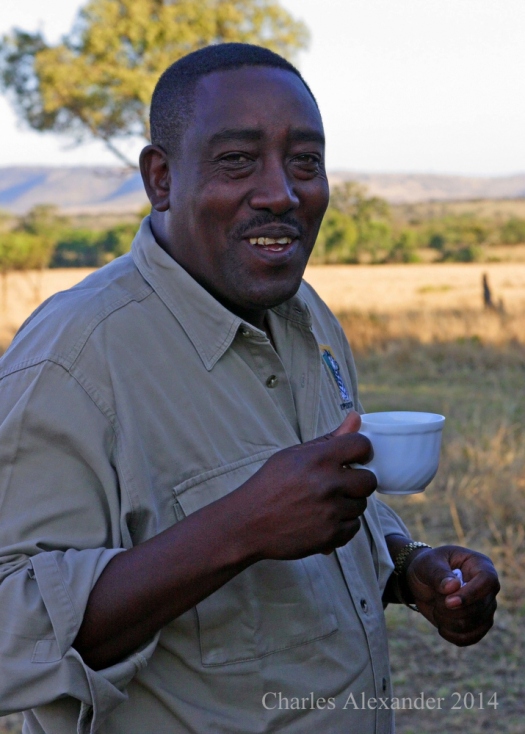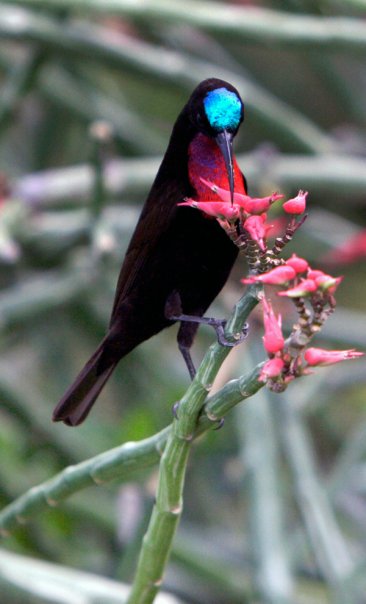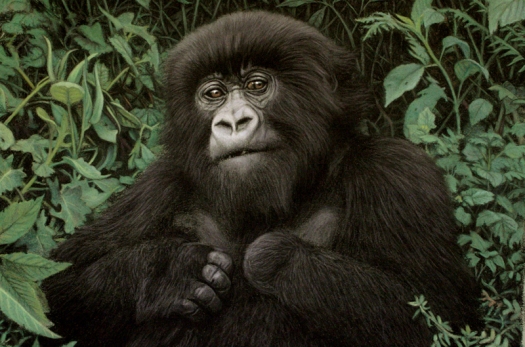Today I’ll at last take you to meet the Amahoros. I can think of no better way to impart the sights, sounds, and emotions of the journey than to share a page from my Rwanda journal, written while my impressions of the day were at their most vivid:

” Last day in Rwanda. This morning I tracked the Amahoro group of gorillas for a second time– they were so close to the wall of porous lava stones that surrounds the Parc National des Volcans that we could hear the tinkle of goat bells, the lowing of cattle, and the laughter of the shepherd boys drifting up from the fields beyond the wall.

 And yet I felt that I was 10,000 years in Rwanda’s past: surrounded by giant lobelias, stinging nettles, and a thousand other kinds of plants, literally immersed in a “gigantic gorilla salad bowl” as so many have described it.
And yet I felt that I was 10,000 years in Rwanda’s past: surrounded by giant lobelias, stinging nettles, and a thousand other kinds of plants, literally immersed in a “gigantic gorilla salad bowl” as so many have described it.
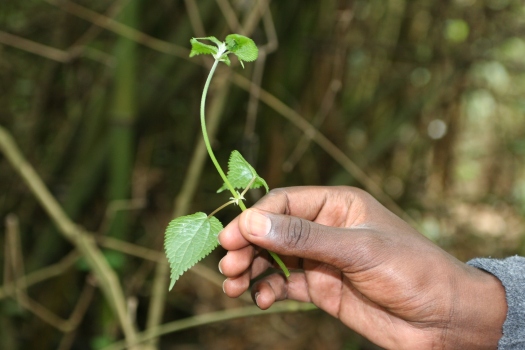
It is truly a shock to leave the world of cultivated fields with a porter and children at your heels, and then to enter the park and follow guide and trackers through the cool shadowy tangle of undergrowth, suddenly hearing the quick pock pock pock of a gorilla beating its chest…


…and an even greater shock to walk a bit more and discover an entire family of mountain gorillas lounging only 15 feet away, framed by lush vegetation as they take their mid-morning siesta after several hours of early morning feeding.

The Amahoros had made their day nests by the time we arrived, flattening the vegetation, and were framed all around by exquisitely formed lobelias, then by groves of native bamboo in the mid-distance, followed at last by the mist-shrouded peak of Mt. Bisoke itself. The gorilla mothers spend most of their rest time watching their hyperactive children at play while silverback Ubumwe keeps an eye on every group member.
 Even when napping his senses are attuned to any hint of danger that might threaten the safety of his family. He is always making deep rumbling sounds to communicate his orders to the group and is also quick to break up a squabble with little more than a rumble and a look.
Even when napping his senses are attuned to any hint of danger that might threaten the safety of his family. He is always making deep rumbling sounds to communicate his orders to the group and is also quick to break up a squabble with little more than a rumble and a look.
The young ones spend most of the group’s rest time climbing over the ever-patient adults and playing games. This morning one youngster climbed on his mother’s head and waved and beat his chest.
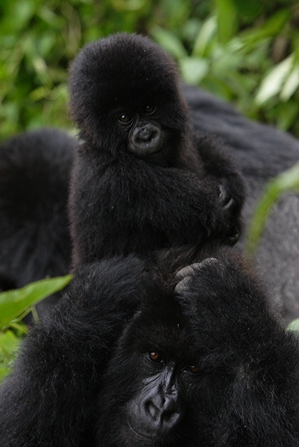
I am going to miss Rwanda– the spectacular terraced fields that make a patchwork of the Virunga landscape right to the edge of the Parc National des Volcans…

……the excited children racing alongside the vehicle, smiling and showing me how fast they can run and calling ” Agachupa!” (plastic bottle!); the beautiful faces of the farm workers in the fields and along the road– the women invariably dressed in brightly colored cloths, some balancing heavy loads on their heads…

the spontaneous singing and dancing of the mercurial, mysterious Batwa…
 Driving the bumpy roads crowded with people and livestock (Rwanda is the most densely populated nation in Africa) while Ammon teaches me Kinyaruanda; arriving at the park headquarters at first light and waiting to begin the morning’s tracking while watching black kites and pied crows on the wing with the peaks of the Virunga volcanoes, particularly jagged Mt. Sabinyo, forming a spectacular and somewhat otherwordly backdrop…
Driving the bumpy roads crowded with people and livestock (Rwanda is the most densely populated nation in Africa) while Ammon teaches me Kinyaruanda; arriving at the park headquarters at first light and waiting to begin the morning’s tracking while watching black kites and pied crows on the wing with the peaks of the Virunga volcanoes, particularly jagged Mt. Sabinyo, forming a spectacular and somewhat otherwordly backdrop…
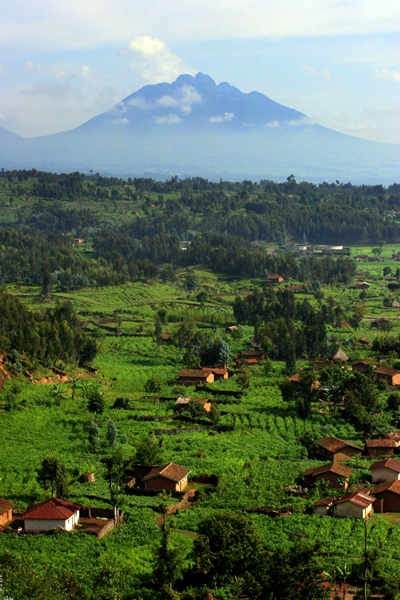
Driving to the starting point at a local village and meeting my porter; walking through miles of fields to the edge of the park, watched along the way by child shepherds tending herds of cattle and goats–I say ” Amarantze, amokoro ki?”– their eyes light up as they respond somewhat shyly with ” Aygo–nemeza”…

…arriving at the stone wall that surrounds the park, then vanishing along a trail into the bamboo zone as we climb to keep our appointment with the day’s assigned gorilla family…
 hearing the cries of golden monkeys and touracos along the way; listening to the wind in the tall bamboo as the stalks creak and groan; savoring the clean, cold mountain air as we climb through meadows of stinging nettles, lobelias, and wild celery, sometimes at a 45 degree angle, sometimes on hands and knees through dense thickets…
hearing the cries of golden monkeys and touracos along the way; listening to the wind in the tall bamboo as the stalks creak and groan; savoring the clean, cold mountain air as we climb through meadows of stinging nettles, lobelias, and wild celery, sometimes at a 45 degree angle, sometimes on hands and knees through dense thickets…
 …then sitting peacefully for an hour as I did this morning: surrounded by gorillas and watching them nap and play.
…then sitting peacefully for an hour as I did this morning: surrounded by gorillas and watching them nap and play.

Meeting Roz Carr yesterday afternoon and being welcomed into her home in Gisenyi felt unreal. She has been a hero of mine for close to 20 years–certainly she was everything that I ever imagined her to be: the most loving and courageous person that I’ve ever met.
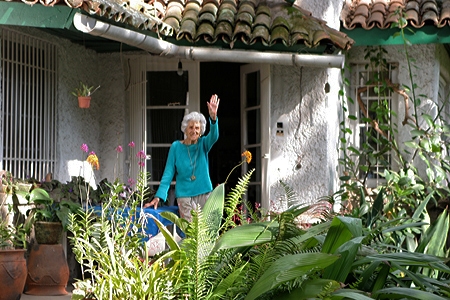
Mrs. Carr first arrived in Rwanda in 1949– and soon fell in love with the land and its people. Her memoir Land of a Thousand Hills: My Life In Rwanda is essential reading for those interested in this part of Africa. A friend to Dian Fossey, Mrs. Carr was portrayed by the actress Julie Harris in the film Gorillas In The Mist. Shortly after the 1994 genocide in Rwanda–and at the age of 82- she founded the Imbabazi Orphanage at Mugongo Plantation, which has subsequently saved hundreds of Rwandan children from a life on the streets.
Dining later on the terrace at the Kivi Sun Hotel in Gisenyi, on the shore of the gigantic Lake Kivu ( the Congolese border only a mile away) we witnessed the arrival of family and guests to a Tutsi wedding: the tall Tutsi women all in elegant brightly colored robes, the groom in a military uniform; the rusty clunky military band, wheezing out a tired old march, followed by the distinctive contrast of drums speaking clearly and powerfully. Soon, the singing and dancing of the Intore drifted across the grounds as the wedding celebration reached fever pitch.


I walked along the lake shore after dinner, listening to the echo of drums while children splashed in the shallows (no hippo or crocodiles in Lake Kivu) and Europeans strolled the beach; finally driving back to Ruhengeri–the giant active volcano Nyiragongo rising from the fields in the distance against the sky at dusk…

…the stars at night: the meteors, the Milky Way unbelievably bright –more stars than I have ever seen are visible in the African sky; the smell of eucalyptus smoke in the air–rising from countless thatched huts far below; waking up at 5am and doing it all over again…”

“Rwanda is my home, and it is here that I intend to spend the rest of my days. Its beauty is my inspiration. Its struggles have been my struggles. Its grief has been my deepest sorrow. Its people are my strength, and its children are my greatest joy.”
~ Rosamond Carr, Land of a Thousand Hills

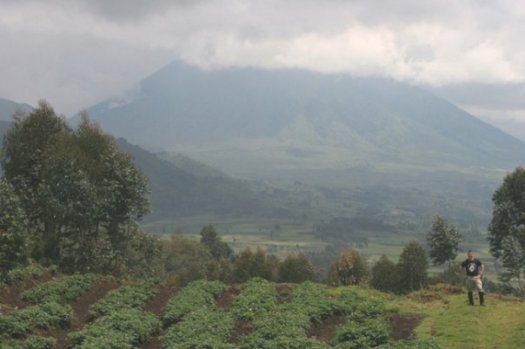
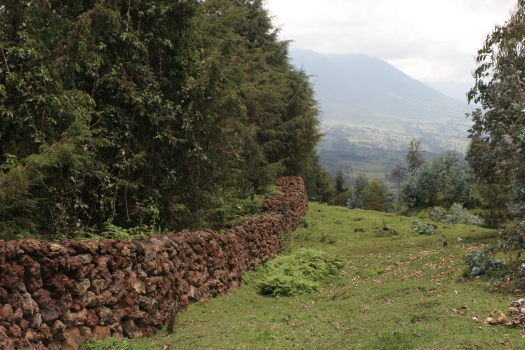









 Terraced fields a few miles outside Kigali
Terraced fields a few miles outside Kigali Ubumwe, silverback of the Amahoro Group
Ubumwe, silverback of the Amahoro Group A colorful, rain-soaked street scene in Kigali
A colorful, rain-soaked street scene in Kigali Mountain road on the way to Ruhengeri. As you can see, the main highways here are very well maintained.
Mountain road on the way to Ruhengeri. As you can see, the main highways here are very well maintained.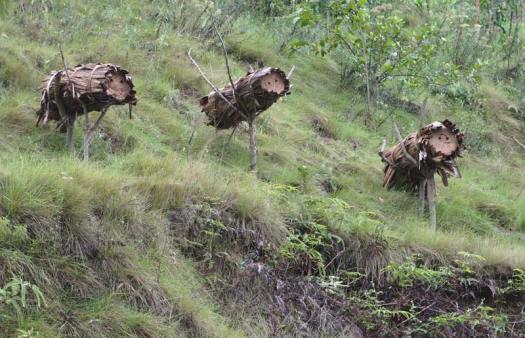 Traditional Rwandan beehives along the road.
Traditional Rwandan beehives along the road. I’ll never forget my first glimpse of the towering Virunga volcanoes as we approached Ruhengeri.
I’ll never forget my first glimpse of the towering Virunga volcanoes as we approached Ruhengeri.
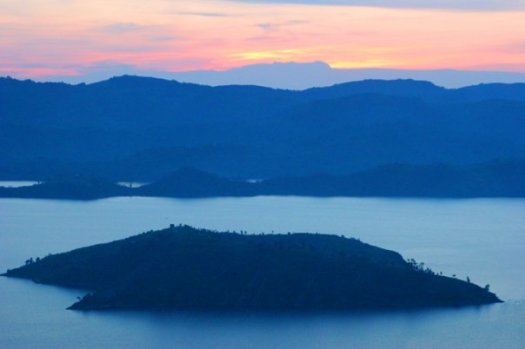
 My driver-guide Ammon of Volcanoes Safaris is a total professional: knowledgeable, patient, eager to share the beauty of Rwanda, and ready to solve any and all problems. He will negotiate with park officials this morning for assigment to my desired group: the Amahoros, a family presided over by the great, gentle silverback Ubumwe. This will be my second visit to the Amahoros, as I want to take a few more reference shots of the silverback and also of the group’s boisterous youngsters at play. Let’s hope that park officials will be accommodating. If the permits for Amahoro have already all been assigned, we’ll have to go with a different group.
My driver-guide Ammon of Volcanoes Safaris is a total professional: knowledgeable, patient, eager to share the beauty of Rwanda, and ready to solve any and all problems. He will negotiate with park officials this morning for assigment to my desired group: the Amahoros, a family presided over by the great, gentle silverback Ubumwe. This will be my second visit to the Amahoros, as I want to take a few more reference shots of the silverback and also of the group’s boisterous youngsters at play. Let’s hope that park officials will be accommodating. If the permits for Amahoro have already all been assigned, we’ll have to go with a different group.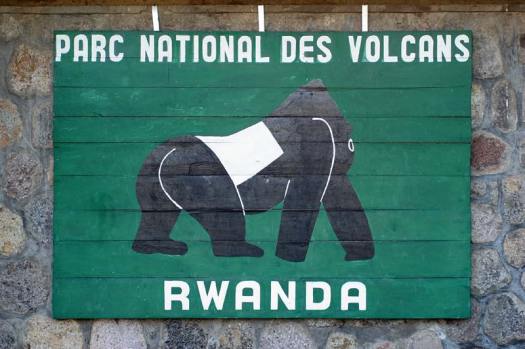
 Others too are waiting here: people from many nations have gathered in the brisk morning air, all eager to trek into the mountains so close at hand to meet the largest of the great apes face-to-face. At last, Ammon emerges from the park office with a smile and good news: our permit for Amahoro has been approved and our trek is about to begin. But first, let’s take a brief but essential crash course in gorilla etiquette.
Others too are waiting here: people from many nations have gathered in the brisk morning air, all eager to trek into the mountains so close at hand to meet the largest of the great apes face-to-face. At last, Ammon emerges from the park office with a smile and good news: our permit for Amahoro has been approved and our trek is about to begin. But first, let’s take a brief but essential crash course in gorilla etiquette.
 A photograph of the Amahoro family. Each gorilla has a unique noseprint that is easily identifiable. The group has 14 members, ranging in age from the elder silverback to curious toddlers. Eager to meet them? Time to get going…
A photograph of the Amahoro family. Each gorilla has a unique noseprint that is easily identifiable. The group has 14 members, ranging in age from the elder silverback to curious toddlers. Eager to meet them? Time to get going…

























 Lord of Eden! As my Tanzania driver-guide Edward and I made our way along the front lines of the Great Migration 100 years later at Bologonja, I knew exactly how White must have felt. The dust, the tumult of tens of thousands of mammals on the move, the cacophony of grunting wildebeest and braying zebras: experiencing a glimpse of the still-living Pleistocene will rock your world forever.Incidentally, many more wildebeest are alive today than in White’s era. The great herds had been decimated by rinderpest in the 1890’s and were only just beginning to recover by 1913. Now is perhaps the greatest time in history to wander among the migration– so get there, if you possibly can! As for White’s assertion that he moved among hordes of “unsophisticated beasts” while in the Serengeti, I can only say that he must not have been well acquainted with elephants! But those were the times that he lived in…
Lord of Eden! As my Tanzania driver-guide Edward and I made our way along the front lines of the Great Migration 100 years later at Bologonja, I knew exactly how White must have felt. The dust, the tumult of tens of thousands of mammals on the move, the cacophony of grunting wildebeest and braying zebras: experiencing a glimpse of the still-living Pleistocene will rock your world forever.Incidentally, many more wildebeest are alive today than in White’s era. The great herds had been decimated by rinderpest in the 1890’s and were only just beginning to recover by 1913. Now is perhaps the greatest time in history to wander among the migration– so get there, if you possibly can! As for White’s assertion that he moved among hordes of “unsophisticated beasts” while in the Serengeti, I can only say that he must not have been well acquainted with elephants! But those were the times that he lived in…


